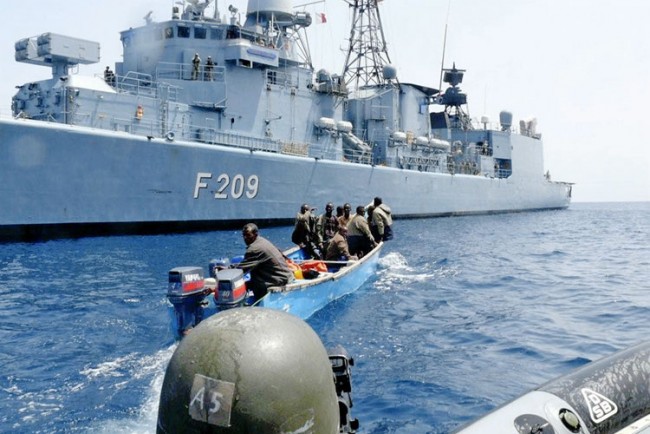
Wednesday, May 7, 2014
By Cassie Werber
A big decline in hijackings off the Somali coast has nearly halved the cost of piracy to the shipping industry, according to a new report, although maritime attacks have grown off West Africa and more than 50 hostages remain in captivity.

advertisements
LONDON—A big decline in hijackings off the Somali coast has nearly halved the cost of piracy to the shipping industry, according to a new report, although maritime attacks have grown off West Africa and more than 50 hostages remain in captivity.A panoply of countermeasures, among them armed guards and patrols by military ships, has all but eliminated successful hijackings. That has pushed down costs of ransom payments, insurance premiums and expensive rerouting of ships around problem zones, says the report, produced by Oceans Beyond Piracy, a Colorado-based nonprofit that since 2010 has charted global piracy.
Oceans Beyond Piracy estimated the overall cost of pirate attacks to the global shipping industry and governments at $3.2 billion in 2013, down from $6.1 billion in 2012.
The report says that there are 54 hostages still being held as a result of piracy, with an average term of imprisonment of nearly three years. Hostage crises are often shielded from media attention while negotiations are ongoing, but the report says that many of the people are held in “deplorable conditions.”
Since 2008, when piracy levels began to ramp up, the shipping industry has made wide-reaching changes. Freight vessels now employ several “passive counter-piracy defense measures” including water cannon, powerful lights, long-range sonic equipment and razor wire, said Giles Noakes, chief maritime security officer at shipping association BIMCO. Warships, provided by several navies, also patrol the highest-risk areas.
Armed guard use on cargo ships has also increased dramatically. In May 2011, the International Maritime Organization provided guidance on the use of armed guards on ships traversing the so-called “High Risk Area,” a 2.8 million square-nautical-mile patch of Indian Ocean stretching between Somalia in the west and India in the east. Now, up to 40% of all transits through the HRA carry guards with guns, said Oceans Beyond Piracy.
No successful hijacks of international ships have been reported since May 2012 thanks to the collective measures, the group said, though four local vessels were hijacked last year.
But the report also notes says there has only been a slight increase in long-term solutions, or those that address the roots of Somali piracy, which include chronic poverty, civil war and weak, unstable governments.
“Until we have more economic opportunity and better governance ashore, we risk piracy returning to previous levels as soon as the navies and guards have gone home,” said Marcel Arsenault, chairman of One Earth Future Foundation, which funds Oceans Beyond Piracy.
Spending on capacity-building in Somalia is only equivalent to 1.5% of piracy’s annual cost, he said.
Meanwhile piracy problems of a different kind are worsening off West Africa, the report said. Report co-author Jens Madsen said poor reporting of piracy and maritime crime in the Gulf of Guinea region make analysis difficult. But it is now widely viewed as the world’s top piracy hot spot.
“We observe not only a high degree of violence in the attacks in this region, but also the lack of a mutually trusted reporting architecture and the constantly evolving tactics of West African piracy makes it extremely difficult to isolate it from other elements of organized maritime crime,” Mr. Madsen said.
Write to Cassie Werber at [email protected]